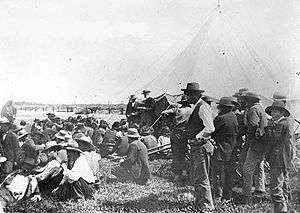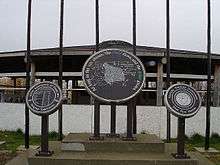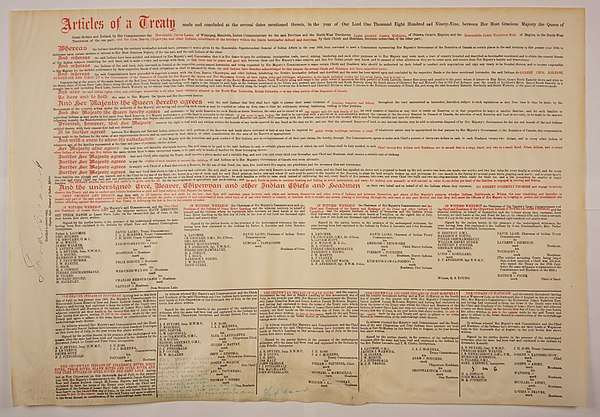Treaty 8
Treaty 8 is an agreement concluded on June 21, 1899, between Queen Victoria and various First Nations of the Lesser Slave Lake area. The treaty was negotiated just south of present-day Grouard, Alberta.
 David Laird explaining terms of Treaty #8, Fort Vermilion, 1899 | |
| Signed | June 21, 1899 |
|---|---|
| Location | Just south of present-day Grouard, Alberta[1] |
| Parties | Queen Victoria and various First Nations of the Lesser Slave Lake area |
| Languages |
|
| Indigenous peoples in Canada |
|---|
|
|
History
|
|
Politics
|
|
Culture
|
|
Demographics
|
|
Religions |
|
Index
|
|
Wikiprojects Portals
WikiProject
First Nations Inuit Métis |

Treaty 8 is one of eleven numbered treaties made between the Government of Canada and First Nations. The Government of Canada had between 1871 and 1877 signed Treaties 1 to 7. Treaties 1 to 7 covered the southern portions of what was the Northwest Territories. At that time, the Government of Canada had not considered a treaty with the First Nations in what would be the Treaty 8 territory necessary, as conditions in the north were not considered conducive to settlement. Along with the Douglas Treaties, they were the last treaties signed between the Crown and the First Nations in British Columbia until Nisga'a Final Agreement.
Background
In the mid-1890s, the Klondike Gold Rush began to draw Europeans northward into the previous undisturbed territory. The increased contact and conflict between First Nations of the region and Europeans prompted the Government of Canada to enter into Treaty 8. In September 1899, the Treaty and Half Breed Commissioners finally concluded the treaty process, with 2217 accepting the treaty, and another 1234 people opting for scrip.
Treaty
The land covered by Treaty 8, 840,000 square kilometres (320,000 sq mi),[2] is larger than France and includes northern Alberta, northeastern British Columbia, northwestern Saskatchewan and a southernmost portion of the Northwest Territories.[3] Adhesions to this agreement were signed that same year on July 1, 1899, at Peace River Landing, July 6 at Dunvegan, July 8 at Fort Vermilion, July 13 at Fort Chipewyan, July 17 at Smith's Landing, July 25 and 27 at Fond du Lac, August 4 at Fort McMurray, and August 14 at Wabasca Lake. Further adhesions were in 1900 on May 13 at Fort St. John, June 8 at Lesser Slave Lake, June 23 at Fort Vermilion and July 25 at Fort Resolution.
Chief Keenooshayoo was one of the First Nations signatories to Treaty 8. First Nations that are considered signatories to Treaty 8 include Woodland Cree, Dunneza (or Beaver) and Chipewyan. Other signatories included David Laird, Father Albert Lacombe, Rev. George Homes, Bishop Émile Grouard, J.A.J. McKenna, J.H. Ross, W.G. White, James Walker, A. Arthur Cote, A.E. Snyder, H.B. Round, Harrison S. Young, J.F. Prud'Homme, C. Mair, H.A. Conroy, Pierre Deschambeault, J.H. Picard, Richard Secord, M. McCauley, Headman Moostoos, Headman Felix Giroux, and Headman Wee Chee Way Sis, Headman Charles Neesotasis.
Albert Lacombe, a trusted Catholic missionary, had been asked by Canadian officials to be present to help convince First Nations that it was in their interest to enter into a treaty. He was present on June 21, 1899, and assured the First Nations that their lives would remain, more or less, unchanged. He was also present at some of the meetings at which adhesions were signed. The elements of Treaty 8 included provisions to maintain livelihood for the native populations in this 840000 km2 region, such as entitlements to land, ongoing financial support, annual shipments of hunting supplies, and hunting rights on ceded lands, unless those ceded lands were used for forestry, mining, settlement or other purposes.[4]

See also
- List of treaties
- Numbered Treaties
- Status of First Nations treaties in British Columbia
- The Canadian Crown and First Nations, Inuit and Métis
References
- "The Making of Treaty 8 in Canada's Northwest". Alberta Online Encyclopedia. 2009. Archived from the original on May 15, 2009. Retrieved August 1, 2009.
- "Treaty 8". Government of Canada. Library and Archives Canada. 2009. Archived from the original on September 20, 2009. Retrieved August 1, 2009.
- "1899 Treaty 8". Prince of Wales Northern Heritage Centre. 2009. Archived from the original on July 6, 2011. Retrieved August 1, 2009.
- "Numbered Treaty Eight". Canadiana.org. 2009. Archived from the original on January 23, 2010. Retrieved August 1, 2009.
External links
- Treaty 8 First Nations of Alberta
- Treaty 8 Tribal Association (British Columbia)
- List of Treaty 8 First Nations in Saskatchewan
- Ray, Arthur J. (1999). "Treaty 8: A British Columbian Anomaly". BC Studies. 0 (123): 5–58. ISSN 0005-2949. Retrieved 13 October 2010.